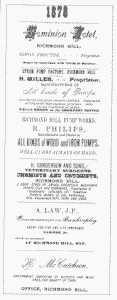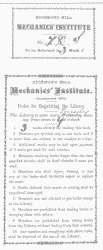Table of Contents
|
Life in the Newly Incorporated Village
 |
| A sampling of business cards
from
Richmond Hill,
1878. |
 |
| Bookplate and rules from the
library of the
Richmond Hill Mechanics' Institute. |
At the time of its incorporation,
Richmond Hill was
certainly an overwhelmingly British/Irish community. Of 134
Richmond Hill
householder surnames listed in
Nason's County of York Directory for 1871,
some 131 reflect either an English, Scottish, or Irish background. The other
three names sound German, although even these residents were likely anglicized
descendants of early arrivals from Pennsylvania or New York, rather than recent
migrants from Europe.
This ethnic homogeneity in a community of six to
seven hundred people was balanced by a broad economic diversity. Like most
Ontario villages of the period,
Richmond Hill
supported a variety of professions and occupations and offered a wide range of
consumer goods and services. This broad base of activity promoted a healthy
commercial (and social) interchange among residents and made the community
largely self-sufficient.
Among the village's 134 heads-of-households listed in
the 1871 county directory, we find:
- nineteen labourers
- eighteen farmers
- nine carpenters and five blacksmiths
- five merchants, two druggists, two shoestore owners, and
one grocer
- three coopers (barrel makers), three saddlers, three
shoemakers, and two tailors
- three "mechanics" and two gardeners
- three hotel-keepers and one publisher/bookseller
- two clerks and two "agents"
- two clergymen (Reverend
Charles Fish of
the
Methodists and
Reverend James
Dick of the
Presbyterians)
- two doctors
(John Duncumb
and
James Langstaff) and one veterinary surgeon
(Henry
Sanderson)
- two justices of the peace
(Parker Crosby
and
Matthew Teefy)
and one barrister
(George
Nichol)
- one butcher and two bakers (but no candlestick
maker)
- a fanning-mill manufacturer, a tannery owner, a pump maker,
a wagon maker, and a carriage maker
- a painter, a pedlar, a brickmaker, a watchmaker, a mason, a
finisher, a sawyer, and a tinsmith
- plus six men listed as retired and five simply as gentlemen
or "gents"
Such were the occupations of the
Richmond Hill men
listed in
Nason's 1871 County of York Directory And
men's names dominated the directory, for most of the
women listed were widows or others running households without husbands present.
Among these few women were:
- two dressmakers (Mrs. M.A. Curts and Mrs. M.
Pollock)
- two milliners (Mrs. Mary Clarke and Mrs. Myers)
- one proprietor of a "Ladies' School" (Mrs. Campbell)
- plus eight other women listed without occupation
Another, less structured view of
Richmond Hill in the
early 1870s is provided by
Fred Crawford,
the village's first "Fire and Nuisance Inspector," who submitted informal
monthly reports through 1874 as letters to the editor of the
York Herald. Crawford wrote with
considerable insight and wit, commenting on all aspects of village life.
Consider these descriptions from his "Odds and Ends" or "Ramble No. 3:"
- Mill Street is in a
deplorable condition; mud and water is all the go. A bridge is wanted in
Ransom's Lane; a
woman and her baby got immersed the other evening in the same place - no lives
lost.
- Foundry in full blast; orders coming in; seven or eight
hands at work;
Mr.
Arnold gives the foundry at a moderate rent to Messrs. Mager &
Quantz, to encourage them and help the town by giving employment to
mechanics.
- Look out for the opening of
Mr.
Atkinson'snew Concrete
store next week; his spring goods are at the station.
- Some boiled oil and white lead wanted badly in the northern
part of the village; a little siding would do no harm either.
- Vacant lots badly fenced; looks bad. The health inspector
will be round in a few days; look out for he is determined to do his duty -
plead no ignorance for you have all seen the by-law on that subject.
- I believe it is the intention of
Mr. Mapes to
start another factory in our village, if he can get a place to suit him - he is
trying hard - and is a good mechanic, and I have seen some of his work; he made
a splendid settee for
Mr. John Velie and
another for Mrs. Hewison. I think the latter is the best.
- Total number of scholars attending our schools, of all
ages, up to this date, 24th March, 140, with five teachers.
- Mrs.
William Atkinson is getting better; no dislocation took place when she
was upset coming from Toronto last week.
- Cleanliness will keep the measles away.
- Very few lately seen drunk in our village and, I suppose,
the reason is that our whiskey is getting mild.
- Young
Sheppard is going ahead; he has a large stock and sells cheap - give him
a call.
- Mrs. Cooper dislocated her ankle and is confined to her
bed.
- A portion of
Mr. Crosby's
spring goods have arrived, and the balance is at the station; a large lot of
garden seeds arrived.
14
By late afternoon or early evening, after
Fred Crawford
ended his daily "rambles," after other members of the community put down their
tools and put away their aprons,
Richmond Hill offered
a variety of organized leisure activities. The
public
school, the
high
school, and the several churches presented musical recitals and
spiritual addresses. Both the
Mechanics' Institute (a nineteenth-century adult education
organization) and the
Agricultural Society sponsored lectures. There were band
concerts and various "amusements" at the
Temperance Hall or
the
Masonic Hall.
Each year brought its own craze, and in 1875 it was the
public spelling bee - a June 1 contest, to be held at the
Masonic Hall. Words
would be chosen from the
Fourth Book in the
Canadian School Readers series, "no proper
names to be given."
Mr. Robertson, a high
school teacher, would act as "pronounciator" for the evening, and harnessmaker
William Harrison
offered as first prize a Webster's Dictionary, "unabridged." The contest was
open to all local residents, "school teachers excepted."
15
Notes
14.
York Herald,March 27, 1874.
15.
Ibid.,
May 14, 1875.
Previous
Next
Copyright © Richmond Hill Public Library Board, 1991
|

